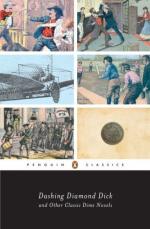|
This section contains 8,384 words (approx. 28 pages at 300 words per page) |

|
SOURCE: “Malaeska's Revenge; or, The Dime Novel Tradition in Popular Fiction,” in Wanted Dead or Alive: The American West in Popular Culture, edited by Richard Aquila, University of Illinois Press, 1996, pp. 21-42.
In the essay below, Bold examines the role of dime novels, pulp fiction, and the commodification of literature in transforming views about the West.
Read collectively dime novels and their descendants tell the story of the frontier West's commodification in popular literature. This process was mediated by changing historical circumstances and individual authorial contributions, from the first intersection of mass literature and westward movement in the mid-nineteenth century to the “nostalgic remorse” for the frontier West of late twentieth-century capitalist culture.1 Early and late, however, the commercial frameworks within which cheap Westerns were produced left their imprint on this fiction's format, formulaic action, narrative voice, and reception.
The mass production of American cheap fiction took off...
|
This section contains 8,384 words (approx. 28 pages at 300 words per page) |

|


